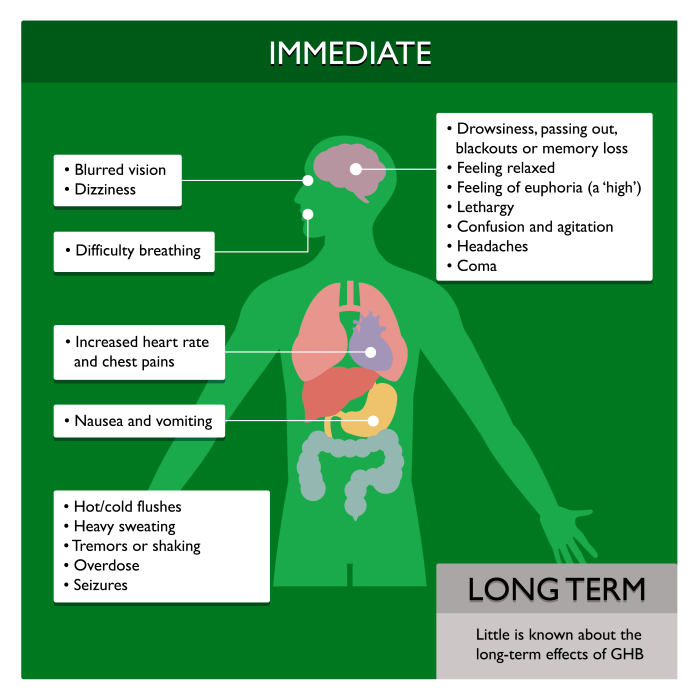What is GHB?
GHB is also known as fantasy, grievous bodily harm, GBH, liquid ecstasy, liquid E, G, or Gina.
GHB is short for gamma-hydroxybutyrate and it is naturally produced in small amounts by the body. It is almost always sold as a clear or blue liquid that doesn't have a smell. It comes in a little vial such as a fish-shaped sushi soy sauce container and it is normally swallowed. Problems with safety, including concerns about its use as a date rape drug, have led to it being classified as an illegal drug.
Sometimes other substances called GBL and 1,4B are sold as GHB because they have similar effects but may be stronger or more toxic. This increases the change of an overdose.
Although it is sometimes referred to as liquid ecstasy or liquid E, it is not related to ecstasy at all.
There’s a very high risk of overdosing with GHB. There’s very little difference between the amount that causes the ‘high’ and the amount that causes an overdose.
What are the effects of GHB?Once swallowed, GHB takes around 15–30 minutes to take effect and the effects last for about half an hour.
The effects of GHB vary but include those listed in the table below.
| Immediate |
Long-term |
| Increased heart rate and chest pains |
Little is known about the long-term effects of GHB |
| Drowsiness, passing out, blackouts or memory loss |
|
| Blurred vision |
|
| Feeling relaxed |
|
| Feeling of euphoria (a ‘high’) |
|
| Lethargy |
|
| Hot/cold flushes |
|
| Heavy sweating |
|
| Confusion and agitation |
|
| Nausea and vomiting |
|
| Headaches and dizziness |
|
| Tremors or shaking |
|
| Difficulty breathing |
|
| Overdose |
|
| Seizures |
|
| Coma |
|

Evidence BaseThis factsheet was developed following expert review by researchers at the Matilda Centre for Research in Mental Health and Substance Use at the University of Sydney, the National Drug & Alcohol Research Centre at the University of New South Wales, and the National Drug Research Institute at Curtin University.
- Degenhardt, L., Darke, S. and Dillon, P., 2002. GHB use among Australians: characteristics, use patterns and associated harm.
Drug and Alcohol Dependence. 67: p. 89-94.
- Chin, M.Y., Kreutzer, R.A. and Dyer, J.E., 1992. Acute poisoning from ?-hydroxybutyrate in California. Western Journal of
Medicine. 156: p. 380–384.
- Sindicich, N. and Burns, L., 2012. Australian Trends in Ecstasy and related Drug Markets 2011. Findings from the Ecstasy and
Related Drugs Reporting System (EDRS). Australian Drug Trend Series No. 82. , National Drug and Alcohol Research Centre,
University of New South Wales: Sydney.
- Carter, L.P., Pardi, D., Gorsline, J. and Griffiths, R.R., 2009. Illicit gamma-hydroxybutyrate (GHB) and pharmaceutical sodium
oxybate (Xyrem): differences in characteristics and misuse. Drug and Alcohol Dependence. 104(1-2): p. 1-10.
- Australian Institute of Health and Welfare, 2023. National Drug Strategy Household Survey 2022-2023 report, AIHW: Canberra.
- Schwartz, R., Milteer, R. and LeBeau, M., 2000. Drug-facilitated sexual assault (‘date rape’). Southern Medical Journal. 93(6):
p. 558-561.
- Chakraborty, K., Neogi, R. and Basu, D., 2011. Club drugs: review of the ‘rave’ with a note of concern for the Indian scenario.
Indian Journal of Medical Research. 133(June): p. 594-604.
- Dillon, P., 2009. Club drugs, updated, National Drug and Alcohol Research Centre, University of New South Wales: Sydney.
- Quigley, P., Lynch, D.M., Little, M., Murray, L., Lynch, A.M. and O’Halloran, S.J., 2009. Prospective study of 101 patients with
suspected drink spiking. Emerg Med Australas. 21(3): p. 222-8.
- Dietze, P., Cvetkovski, S., Barratt, M. and Clemens, M., 2008. Patterns and incidence of y-hydroxybutyrate (GHB)-related
ambulance attendances in Melbourne, Victoria. Medical Journal of Australia. 188: p. 709-711.